Home Entertainment Blog Archive
Brought to you by your friendly, opinionated, Home Entertainment and Technology writer, Stephen DawsonHere I report, discuss, whinge or argue on matters related to high fidelity, home entertainment equipment and the discs and signals that feed them. Since this Blog is hand-coded (I like TextPad), there are no comments facilities. But feel free to email me at scdawson [at] hifi-writer.com. I will try to respond, either personally or by posting here emails I consider of interest. I shall assume that emails sent to me here can be freely posted by me unless you state otherwise.
This archive is for an uncertain period commencing Thursday, 16 November 2006
I've been saying pretty much from the start that eventually there will be dual format HD DVD/Blu-ray players. But I wasn't expecting it for maybe three or four years. Well, the pace of technological improvement continues to accelerate, and already there is a hybrid HD DVD/Blu-ray player from LG (in the United States, anyway). Apparently the LG BH100 is less than perfect, but that's unimportant. What is important is the proof of concept.
Meanwhile, Warner Bros (which supports both HD DVD and Blu-ray) has announced a new hybrid disc with both HD DVD and Blu-ray content. If these work okay that will deal with the one remaining problem of the two formats: inventory management.
 We all know that 'The Simpsons' is hilarious. And it sometimes pushes the boundaries for taste, usually for those who don't quite get it.
We all know that 'The Simpsons' is hilarious. And it sometimes pushes the boundaries for taste, usually for those who don't quite get it.
I recall hearing some young fellow ring up the John Laws radio talk back program last year complaining about how negatively Australia had been portrayed on 'The Simpsons'. Presumably he was talking about the episode 'Bart vs. Australia' (Season 6, Episode 16), in which Bart has to go to Australia to receive the alleged traditional punishment for his misdeeds of the boot in the behind. Of course, 'The Simpsons' is just as unkind to the French and the Albanians, the Japanese, the Scots, and just about every other nationality you care to name, not the least Americans.
But the immediate reason for this post is that this evening, at 6pm, the regular repeat episode of 'The Simpsons' was 'E-I-E-I-(Annoyed Grunt)' which contains what James Lileks once called 'the filthiest joke ever broadcast on network TV'. I certainly didn't get it until I read that post. Do you?
Some years ago I received a DVD player for review. Before I had a chance to get it out of the box, I received a call from the PR company. The previous reviewer had accidentally left a DVD in it, so could I post it to him? Sure, not a problem.
In case that reviewer happens to be reading this, don't worry: I can't remember who you are, or even which particular brand of DVD player I was reviewing. You see, the said disc turned out to be an adult movie (I shall avoid the 'p' word so as not to tempt Net Nanny and the like to blacklist this site).
Now I read that Sony apparently says it will not source its Blu-ray discs from disc replicators which also produce discs for the adult film industry. Apparently Disney has the same policy.
I have been fairly dismissive of claims that either Blu-ray or HD DVD is significantly superior to the other. Blu-ray is perhaps a little more attractive because of the greater disc capacity. But so far it has largely negated that by using the MPEG2 video compression scheme for most releases (certainly, all that I've seen), rather than the more efficient systems available (all the HD DVD discs I've seen use the more highly developed, and much newer, VC-1 system).
In order to achieve its higher capacity, the Blu-ray crowd have re-designed the discs themselves. DVDs, HD DVDs and BDs (Blu-ray Discs) are all 1.2mm thick. But DVDs and HD DVDs have their data half way down through the disc's thickness: that is, they have a 0.6mm layer of transparent plastic on top of the data. BDs have the data much nearer to the playing surface, just 0.1mm down. To overcome possible damage to the data from scratches and the like, BDs use a much harder plastic.
This closeness of the data layer to the surface is what allows the higher data density.
Toshiba has often touted the more traditional structure of HD DVDs as an advantage of its format. It argues, probably correctly, that current DVD production equipment can be used to produce HD DVDs, rather than the expensive new equipment required for Blu-ray. I haven't found this a persuasive argument because whichever the format, disc production costs are a tiny percentage of the release costs of any movie.
But this story puts a new slant on it. If you have invested in expensive new equipment for BD production, would you be prepared to eliminate from your customer list both Disney and Sony (which owns the Columbia, TriStar and MGM movie catalogues) in order to press Blu-ray adult films? DVD production equipment, though, is relatively cheap.
So expect high definition adult material to appear on HD DVD rather than Blu-ray. The more cynical may suggest that this will ensure the success of HD DVD and the eventual demise of Blu-ray. I doubt it myself, but it will be interesting to see what does happen.
UPDATE (Wednesday, 11 April 2007, 12:22 pm): Looks like this isn't going to be the case after all.
 It isn't easy to be a TV cinematographer these days. The other night I was watching
Medium on high definition TV. The pre-titles opening scene was, as usual, one of Alison Dubois' dreams. Mrs Dubois is the titular Medium, and every week she solves some murder in Phoenix, Arizona, thanks to her ability to communicate with, or at least receive dreams informed by, the dead.
It isn't easy to be a TV cinematographer these days. The other night I was watching
Medium on high definition TV. The pre-titles opening scene was, as usual, one of Alison Dubois' dreams. Mrs Dubois is the titular Medium, and every week she solves some murder in Phoenix, Arizona, thanks to her ability to communicate with, or at least receive dreams informed by, the dead.
But just as important in the progress of the show is her family: her husband Joe (essentially, a rocket scientist) and her three daughters.
In the episode of interest, Very Merry Maggie, the dream is of her and her family, represented by dolls. Photographing small objects, such as dolls, is difficult to get right. The use of any form of macro lens induces a very limited depth of field, so focus has to be absolutely perfect. Unfortunately, in this episode, the camera-people didn't quite pull it off. Some of the doll shots were nicely sharp, while others were quite fuzzy. I doubt that you would notice this on a good old-fashioned CRT TV, but with a Runco VX-2000 projector, with its 1,920 by 1,080 pixel resolution ($AUS36,000), fed from a Strong SRT-5490 high definition TV receiver, with a 1,440 by 1,080 pixel high definition digital TV signal, this difference became obvious.
This (shown to the right) isn't the only example. Quite often live shots exhibit variable focus sharpness. This is most obvious during dialogue, when the camera is switched between the participants. Sometimes I've even noticed the camera focus searching, going a little either side of accuracy, before settling on the right setting.
This is something you don't see in movies. Looks like TV cinematographers are going to have to work a little harder.
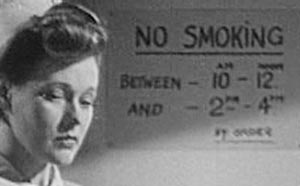 A couple of people have emailed me, politely I'm happy to report, wondering whether I'm ever again going to add something to this blog. For the past, ugghh!, four months I haven't felt inspired enough to add anything new here. I'll try to do better.
A couple of people have emailed me, politely I'm happy to report, wondering whether I'm ever again going to add something to this blog. For the past, ugghh!, four months I haven't felt inspired enough to add anything new here. I'll try to do better.
In the meantime, the other night I watched a movie on ABC called Green for Danger, a very good little murder mystery set in a war-time hospital in the UK. Well worth checking out, with brilliant dialogue by the Alistair Sims character. My eye happened on a scene set in the patient ward. Notice the sign tacked up on the wall. How times have changed.
I received an email today, originating from Panasonic, in which polite issue was taken with a statement I had made in a review I had written of the Panasonic DMP-BD100 Blu-ray player. The statement was: 'there is five times as much detail in a Blu-ray movie than there is in its DVD equivalent.'
Panasonic noted that 'Technically speaking, "a Blu-ray disk can have up to 10x the resolution of a conventional DVD".' Naturally, I disagree. What follows is based largely on my response.
This is correct -- potentially, and in a limited range of circumstances.
If the original source was captured using a 1080p50 camera, then there would indeed be 10 times the amount of data compared to a 576i50 camera (pps= pixels per second):
576i50 capture: 720 pixels x 288 pixels x 50 hertz = 10,368,000ppsIt is actually even higher in the US where 60 hertz systems are used:
1080p50 capture: 1,920 x 1,080 x 50 = 103,680,000pps
Ratio is 10:1
480i/60: 720 x 240 x 60 = 10,368,000ppsSo, to be completely accurate, one should say that Blu-ray/HD DVD can deliver up to 12 times the number of pixels.
1080p60: 1,920 x 1,080 x 60 = 124,416,000pps
Ratio is 12:1
So that's the potentiality, and all it awaits is the extensive use of 1080p50 or 60 video cameras.
But back to the present. The great majority of DVD and Blu-ray/HD DVD content is derived from either film, or film-like video camera (eg, Episodes 1-3 of Star Wars). These run at 24 frames per second.
Let us consider one film frame. With, say, 576i50 telecining, this is indeed captured in each cycle at a resolution of only 720 by 288 pixels, to constitute the first field. But there are two fields. The following cycle also captures only 720 by 288 pixels, but these are actually different pixels to those captured in the first cycle. The first cycle captures one set of 288 horizontal lines, reaching from the top to the bottom of the screen, while the second cycle captures the in-between set of lines. So the total amount of information captured for that frame is 720 by 576, which is 414,720 pixels.
With 1080p telecining, you would be mad to capture the exact same film frame twice. All that does is double the amount of data to store. So each film frame is captured once, at full HD resolution of 1,920 by 1,080, which is 2,073,600 pixels. All film-sourced content on Blu-ray discs, which I have confirmed with Twentieth Century Fox, Warner Bros and Sony Pictures Entertainment, will be presented on Blu-ray in the 1080p24 format.
So, right now, with virtually all currently available content, and for the great majority of content into the forseeable future, the number of pixels per frame for most Australian DVDs and Australian BDs are:
DVD: 720 x 288 x 50 = 10,368,000ppsThis is being unfair to BD because the DVD is running the movie around 4% fast (actually, 4.1666 repeated). So in terms of actual total data presented per film frame we have:
BD: 1,920 x 1,080 x 24 = 49,766,400pps
Ratio is 4.8:1
DVD: 720 x 576 = 414,720 pixelsI think that justifies my claim (note, I specifically said 'Blu-ray movie'). The important point to remember is that everything is limited by its source. A 1080p projector can't really lift a 576i DVD out of its humble origins, and a 1080p60 BD can't generate more data out of a 24 frame per second movie than was originally contained in the frame.
BD: 1,920 by 1,080 = 2,073,600 pixels
Ratio is exactly 5:1
But that does bring me to one point which: the output of the current Blu-ray players is 1080p60 or 1080i60. In either case, this damages the 1080p24 source.
The reason is that the 24 film frames in each second must be translated into 60 BD frames per second. How to do this? Consider four sequential film frames, which I'll call A, B, C and D. When shown in a cinema, a technique of double shuttering is used to eliminate flicker. This is straightforward: each film frame is exposed twice, thus: A A B B C C D D. So in modern terms, you might say that the output of a cinema film projector is 48p.
But with the DMP-BD60's output at, say, 1080p60, extra frames are required (24 is not a factor of 60). So the film frames are shown as so:
A A A B B C C C D DAs you can see, every second film frame is displayed for 50% longer than the intermediate ones. This is painfully obvious when watching Blu-ray discs. Camera pans become jerky, and so does other movement which should be smoothly moving. Watch the credits roll up on the end of a DVD movie, then watch them on a BD and the difference will be obvious.
The obvious solution is to produce a Blu-ray disc player capable of outputting 1080p24 (or 1080p48, but that's unnecessary). I note that most modern 1080p display devices are capable of accepting 1080p24 input. So why won't current Blu-ray players deliver it?
It was recently time for a retirement. Back in September 2000 I purchased a digital camera as an aide in my writing work. It was an Olympus C-3030Z. Three megapixels, decent quality optics, it cost around $2,000.
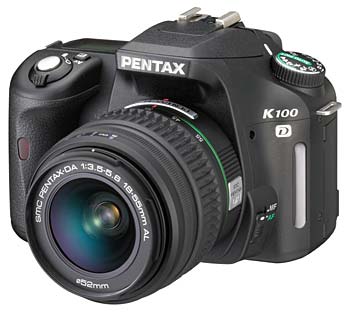 Since then it has been to Bangkok, Hong Kong, Singapore, Los Angeles, London, Paris, Tokyo, Osaka, and a few other places, and served me well. But it was always a bit limited. I learned photography on a Pentax K1000 SLR (with which my eldest daughter is now also learning photography). Fully manual, it is the kind of camera you could still use after civilisation collapses, requiring no batteries at all.
Since then it has been to Bangkok, Hong Kong, Singapore, Los Angeles, London, Paris, Tokyo, Osaka, and a few other places, and served me well. But it was always a bit limited. I learned photography on a Pentax K1000 SLR (with which my eldest daughter is now also learning photography). Fully manual, it is the kind of camera you could still use after civilisation collapses, requiring no batteries at all.
The Olympus was also getting a little cranky, had developed three crook pixels (which isn't bad out of three million and six years) and had always been a demon on batteries.
So I did my research and reverted to Pentax, in this case the K100D digital SLR. This was available as a package with a couple of Sigma lenses for around $AUS1,100. Why choose Pentax rather than Olympus or Canon or Nikon? Two reasons. The first is that it was cheaper. The second was that the closest price competition, from Olympus, uses a proprietary rechargable battery pack. I always feel far more comfortable knowing that, at a pinch, I can buy a stack of AAs just about anywhere in the world to keep on going.
Of course I quickly added a couple of new sets of NiMH batteries (it takes four, and seems to deliver about 300 to 400 shots on a fresh charge), a backup set of Lithium batteries and a couple of SD memory cards. Between them, the 1GB and 2GB cards are good for around a thousand photos at the highest quality JPEG setting (good enough for my purposes, and the RAW format used by Pentax seems to be a peculiar, non-standard one).
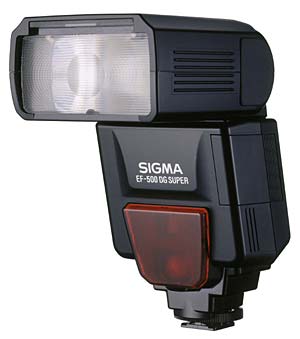 And then there was the issue of a flash. The K100D has a built-in pop up flash, which is okay I suppose in an emergency. But it is just no good at all for taking pictures of home entertainment equipment, producing bright reflections and such. A flash attached to the hot shoe, fitted with a swingable head, seemed to be the answer.
And then there was the issue of a flash. The K100D has a built-in pop up flash, which is okay I suppose in an emergency. But it is just no good at all for taking pictures of home entertainment equipment, producing bright reflections and such. A flash attached to the hot shoe, fitted with a swingable head, seemed to be the answer.
So I made some more enquiries. Pentax makes a flash designed to work nicely with the K100D, but this was out of the question. Few shops carried it (one said that no-one buys it because it is too expensive), and the going price was upwards of $AU700. However Sigma makes flashes for most camera brands (the flash is the same, but the hot shoe is different to match the proprietary contacts), including the Pentax *ist and the K100D. The model is EF-500DGST.
This offers proper Through-The-Lens metering, a low light focus assist, red-eye reduction pre-flash, automatic zoom (28mm to 105mm for 35mm film camera lenses) and a flash head that both swings up (and down a little for macro shots) and sideways so that you can bounce the flash for diffuse lighting. Just what I needed.
As it happened, Ted's Camera Stores had a special on the flash: $AUS199 instead of the usual $299 (or more at some shops). So I raced in and bought one. And that's when things went weird.
Once I got home, the flash worked beautifully ... when it worked at all. Oh, it always flashed, but sometime the exposure was so dark as to make me think that the sync failed and it had flashed either before the shutter had opened, or after it had closed.
 So then I did some experiments. The flash always worked properly if the aperture on either lens was set to less than F4.5. It also always worked properly if the head was significantly swivelled, or significantly swung up. But if pointed directly at the subject, with an aperture of F4.5 or greater, it just would not work at all. How's that for strange!
So then I did some experiments. The flash always worked properly if the aperture on either lens was set to less than F4.5. It also always worked properly if the head was significantly swivelled, or significantly swung up. But if pointed directly at the subject, with an aperture of F4.5 or greater, it just would not work at all. How's that for strange!
I reluctantly returned the flash and got my money back. Then I contact the distributor, which imports both Pentax and Sigma products. Their service department said promptly that this was a known issue. Both the camera and the flash needed to have their firmware upgraded. The Pentax I could do myself with a download (to version 1.1 from 1.0), but the flash had to have its done in their workshop.
I rang Ted's and the chap who had been dealing with me regarding the flash agreed to send it back to Melbourne. A few days later it was done, and now it works perfectly.
Anyway, I like this camera a great deal, and the flash allows me to capture equipment shots that were always beyond the capability of the Olympus C-3030Z. But if you are contemplating this combo, get an assurance that both products have the appropriate firmware, and try them out together in the shop.
Now all I need is a cable to allow me to mount the flash away from the camera. Pentax makes the cable (and the attachments for either end for connecting to the camera's hot shoe and the base of the flash), but this was close to $AUS300. Ouch!
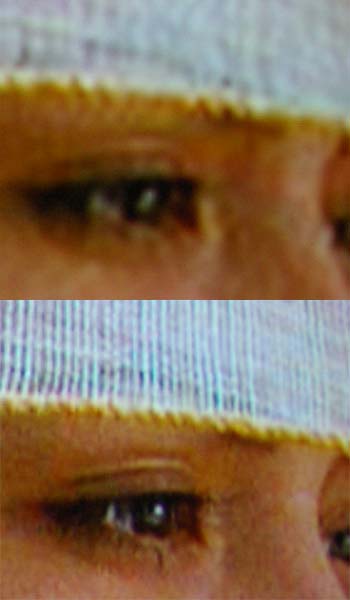 Well, judging by the detail of the pictures shown to the right, it most certainly looks like Blu-ray is much better than DVD. The discs concerned are the Region 4 DVD of A Knight's Tale and the Blu-ray version thereof. The top picture is, of course, the DVD, with a close detail of a scene around 38:01 into the movie (it's a little later with the Blu-ray version since this operates at 60 hertz and, therefore, the timing is accurate).
Well, judging by the detail of the pictures shown to the right, it most certainly looks like Blu-ray is much better than DVD. The discs concerned are the Region 4 DVD of A Knight's Tale and the Blu-ray version thereof. The top picture is, of course, the DVD, with a close detail of a scene around 38:01 into the movie (it's a little later with the Blu-ray version since this operates at 60 hertz and, therefore, the timing is accurate).
In both cases the picture was paused. I had the DVD player, a Denon DVD-S52, set to 'Frame' for its still mode to ensure that it wasn't halving the vertical picture resolution when it was paused (DVD players do this if they think that the picture is interlaced, and since almost all PAL discs are incorrectly flagged 'interlaced', they do just that). The Blu-ray player was the Panasonic DMP-BD10. In both cases, the player was connected to the projector with a HDMI cable. The output of the Blu-ray player was 1080p, while that of the DVD player was 576p.
Hah, gotcha, you may say. If the DVD player was scaling up to 1080p, then the picture quality would be better. But I'm afraid not. I initially used the new Denon DVD-2930 for the DVD shot, with its output set to 1080p via HDMI. But this produced an even softer, less detailed image than the Panasonic DVD player. The reason I switched was that I had intended to ensure that the Denon was in frame still mode, but couldn't find an option in its setup menu for that. Thus the swap.
The projector was the new Panasonic PT-AE1000E, a 1,920 by 1,080 LCD projector which retails for $AUS7,699. That's a fine projector indeed.
I took the photos with my new Pentax K100D digital SLR, tripod mounted, using a remote shutter release. The exposure was around a tenth of a second.
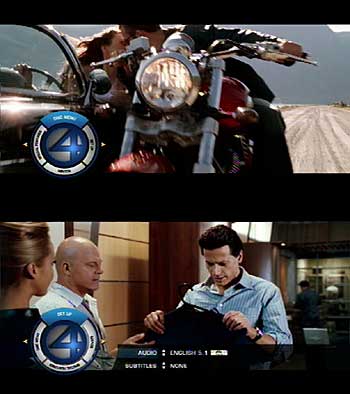 Blu-ray has many wonderful things going for it, especially the sheer detail of the picture quality (more on this on another day). But one of the coolest things for me are the pop-up menus.
Blu-ray has many wonderful things going for it, especially the sheer detail of the picture quality (more on this on another day). But one of the coolest things for me are the pop-up menus.
Blu-ray is capable of delivering three separate video layers. One of these is typically used by subtitles, so that leaves two. What do you do with them? Well, the main one can run the movie, while the other one can have pretty much anything over the top of it (including video commentary). So far, this has been used for popup menus.
With DVDs you have to return to the main menu if you want to, say, access the scene selections or the language menu. With Blu-ray, you don't need to do this at all. Just hit the 'popup menu' key on the remote, and the main menu appears overlaid on top of the movie, even while it continues to run.
To the right are a couple of screen shots from Fantastic Four, with the pop up menu right over the top of the movie. The top one shows the menu, while the second shows the audio selections invoked from that menu. All the while the movie proceeded regardless. (In reality, the menu quality is better than shown here. I used a composite video connection from the Panasonic DMP-BD10 Blu-ray player to grab these pictures, and the quality is pretty mediocre from that.)
FF is on a 20th Century Fox BD (Blu-ray disc). They have sent me three others: Kiss of the Dragon, Kingdom of Heaven and The Transporter. FF is implemented in a similar manner to DVDs, and to the Sony Pictures Entertainment discs I have acquired: it has the usual main menu which you enter when you start the disc. But the other three discs mentioned are different. When you insert the disc, it runs the 20th Century Fox logo, then it runs it again. But the second time, the logo is actually the start of the movie. Initially I thought it was skipping the main menu and running the movie immediately. But when I hit the menu key, I just got the red no-go crossed circle at the top right of the screen. Turns out that there are no main menus on these movies. Everything is done through the popup menus.
Mind you, these are test discs, so the final product may be different. But that seems unlikely since everything else seems to be present on these discs.
 Just received a press release from Topfield. It has now released its TF7000HDPVRt. That string of letters at the end have meaning: t=terrestrial (ie, as opposed to satellite), PVR=Personal Video Recorder, and HD=High Definition.
Just received a press release from Topfield. It has now released its TF7000HDPVRt. That string of letters at the end have meaning: t=terrestrial (ie, as opposed to satellite), PVR=Personal Video Recorder, and HD=High Definition.
Price? $1,299.
The natural competitor to this is the Strong SRT 5490 HD PVR. Obviously I shall be seeking to get ahold of the Topfield, but in the mean time here's the obvious differences:
| Feature | Strong SRT-5490 HD PVR | Topfield TF7000PVRt | Comment | |||||||||||||||||||||||
|---|---|---|---|---|---|---|---|---|---|---|---|---|---|---|---|---|---|---|---|---|---|---|---|---|---|---|
| Digital output | DVI + coax and optical audio | HDMI + coax and optical audio | Since the Topfield will send its audio via HDMI, it wins here | |||||||||||||||||||||||
| Video output switching | Must choose via remote key or setup menu | Several (all?) available at the same time | Topfield is a winner here as well. | |||||||||||||||||||||||
| Computer connectivity | USB (apparently 1.1 speed) and Ethernet | USB 2.0 | I love the Strong's Ethernet capabilities, I score this one to it | |||||||||||||||||||||||
| Media features | Can show JPEG and play MP3, or transfer out recordings, via Ethernet or USB | Can tranfer out recordings via USB | Both the JPEG and MP3 functions of the Strong being fairly worthwhile, so I think Strong wins this one | |||||||||||||||||||||||
| Tuners | Two, record two and play back a third, PIP | Two, record two and play back a third, PIP| Navigation | Excellent | Looks the same on paper |
| File editing | No | Not stated, so I assume no |
| Time shifting | Yes, but has to be explicitly selected | Yes, but how it works I don't know. Hopefully like the TF5000PVRt |
| Reliability | Excellent with the 2.0.5 firmware | Topfield's reputation is excellent, but we'll have to wait and see |
| Hard Disk | 250GB | 250GB |
| Price | $1,299 | $1,299 |
| |
Looks like another exciting product.